What is the appearance of the constellation Southern Cross in the Southern Hemisphere? Where can it be found on the star map? Learn interesting facts, legends, and myths associated with this constellation. Explore photos of stars, including Akruks and Hakruks, as well as nebulae.
The Southern Cross refers to a constellation positioned in the southern region of the sky. It is recognized as the smallest constellation among the total of 88 constellations.
Despite its small size, the constellation has gained significant popularity in the southern hemisphere. It takes the shape of a cross, formed by the five brightest stars. The Southern Cross holds great historical significance and has influenced numerous cultures across the southern hemisphere. Notably, it holds utmost importance to Australia and New Zealand, as it remains visible throughout the year in these regions.
In the northern hemisphere, you won’t find the Southern Cross constellation north of +20°. To see it, you need to look at the circumpolar south at 34° where it never hides behind the horizon. It is positioned opposite the constellation Cassiopeia. The name Crux is derived from the Latin word for “cross.” In ancient Greece, it was believed to be part of the Centaurus constellation. While these stars were featured on celestial globes, it wasn’t until 1679 that it became an official constellation, thanks to French astronomer Augustin Royer. Some argue that the credit should go to Dutch astronomer Peter Plancius, who created it in 1613 and had it published by Jacob Bartsch in 1624.
Facts, location, and map of the Southern Cross constellation
The Southern Cross constellation is known for its small size, covering an area of only 68 square degrees. It holds the 88th position among all constellations. Located in the third quadrant of the southern hemisphere (SQ3), it can be observed at latitudes ranging from +20° to -90°. The Southern Cross is adjacent to and .
| Crux |
| Cru |
| Southern Cross |
| 11 h 50 m to 12 h 50 m |
| -64° to -55° |
| 68 sq. deg. (88th position) |
The stone representation of the constellation was observed in Machu Picchu, Peru. It was referred to as Chacana, meaning “Ladder” by the Incas and Te Punga, meaning “anchor” by the Maori people. The Australian Aborigines identified it as the head of an Emu in the sky. Notably, the Southern Cross is featured on the flags of Australia and Brazil. It is also mentioned in the Brazilian national anthem and was the name of the currency in Brazil between 1942-1986 and 1990-1994.
In 1501, Amerigo Vespucci first noticed the stars, but a more precise representation was documented in 1515 by Andrea Corsali. The Southern Cross appeared on Peter Plancius’ globes in 1598, based on observations by Peter Dirkszoon, and on Jodocus Hondius’ globes in 1600.
The primary stars of the Southern Cross constellation
Discover the brilliant stars within the Southern Cross constellation of the southern hemisphere, accompanied by detailed explanations, photographs, and profiles.
Acrux (Alpha of the Southern Cross) – holds the top position in terms of brightness within the constellation and ranks 12th in the night sky. It has an apparent visual magnitude of 0.77 and is located at a distance of 320 light years. Acrux is a multiple star system composed of Alpha-1 (a B-type subgiant) and Alpha-2 (a B-type dwarf), separated by 4 angular seconds. Both stars are extremely hot, almost of O-class, with luminosities 25,000 and 16,000 times greater than that of the sun.
Alpha-1 is a spectroscopic double star, consisting of two objects with magnitudes of 14th and 10th, orbiting each other with a period of 76 days. There is another B-class subgiant star within the system, although it is located further away along the same line of sight.
Mimosa (Becrux, Beta Southern Cross) is a binary system with two stars that are 8 astronomical units apart and have an orbital period of 5 years. It has a spectral type of B0.5IV, making it the hottest star in the first magnitude.
With a visual magnitude of 1.30, Mimosa is the second brightest star in the constellation and the 20th brightest star in the sky. It is located approximately 350 light-years away from our solar system. Mimosa is also classified as a Beta Cepheid variable star. It can only be observed in regions south of the Tropic of Cancer (23°26’16”). The star is approximately 10 million years old and is nicknamed “Mimosa” due to its color. It represents the state of Rio de Janeiro on the flag of Brazil.
Hakruks (Gamma of the Southern Cross) is a red giant (M4III) with an apparent visual magnitude of 1.59 and a distance of 88 light-years. It is the third brightest star in the constellation and the twenty-sixth brightest star in the sky. Hakruks is actually a binary star system, with the main body belonging to the spectral class M4 III and the second star being a white star of class A3 with a visual magnitude of 6.4. The companion star is located 400 light-years away from Hakruks.
Decrux (Delta Southern Cross) is a subgiant star (B2IV) with an apparent magnitude of 2.775 and a distance of 360 light-years. It is classified as a Beta Cepheus-type variable star, meaning its brightness fluctuates over time.
Zeta Southern Cross is a double star system consisting of a blue-white dwarf star (B2.5 V) and a companion star with a magnitude of 12.49. The total apparent visual magnitude of Zeta Southern Cross is 4.04. It is located 360 light-years away from the Sun.
Epsilon of the Southern Cross is an orange giant star (K3III) that has a visual brightness of 3.56 and is located 228 light-years away. This star is prominently featured on the flag of Brazil, representing the state of Espírito Santo.
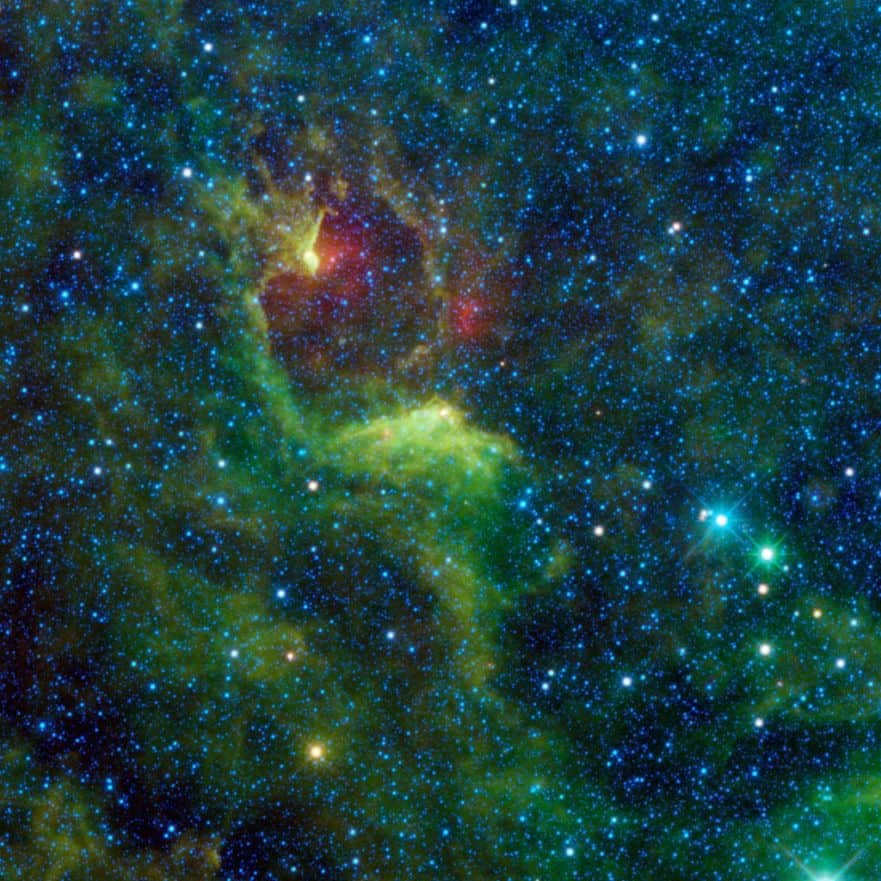
Theta of the Southern Cross consists of two distinct star systems.
Theta-1 is a binary star system with a spectral class of Am. Its visual magnitude is 4.30 and it is located 230 light years away.
Theta-2 is also a binary star system, with the stars orbiting each other every 3.4280 days. It is classified as B2 IV and is situated 750 light years away. The apparent magnitude is 4.72. One of the stars in this system is the variable Beta Cepheus, and its luminosity fluctuates between 4.70 and 4.74.
Lambda of the Southern Cross is a blue-white dwarf (B4Vne) with an apparent magnitude of 4.6. It is located 360 light years away. This star is also a variable Beta Cepheus, meaning its brightness changes due to surface pulsations. Its luminosity varies by 0.02 magnitude over a period of 0.3951 days.
The Southern Cross’s Iota star is an orange giant (K0 III) with a visual magnitude of 4.69 and a distance of 125 light-years. This star has a companion star, a G8-class star with a magnitude of 10.8.
BZ, a star in the Southern Cross (HD 110432), is a B-class subgiant that exhibits emission lines in its spectrum. It is classified as a Gamma Cassiopeia-type variable star, with a gas disk surrounding its equator. It is also an X-ray source, with an apparent magnitude of 5.316 and a distance of 1000 light years. It is situated behind the Coal Sack Nebula.
NGC 4349-127 is a red giant that is nearly 20 times more massive than Jupiter. It is located 7077 light years away from us. Its visible visual magnitude is 7.4 and its absolute magnitude is -4.3. In 2007, a companion star (a brown dwarf) was discovered.
Celestial entities in the Southern Cross constellation
The Dark Nebula known as The Coal Sack (also identified as Caldwell 99) is a celestial formation characterized by a prominent black void within the southern region of the Milky Way galaxy. Encompassing an area of approximately 7 by 5 degrees in the sky, it extends across the adjacent constellations of Centaurus and Fly. With a radius measuring between 30 and 35 light-years, this nebula is positioned at a distance of 600 light years from our planet Earth.

Because of its immense size, the nebula has been observable in the southern hemisphere since ancient times. Amerigo Vespucci referred to it as the Obscure Canopus. The Australian Aborigines perceived it as the emu’s head, a bird that holds a prominent role in various legends and myths.

Introducing the tiniest constellation in the skies of the Northern and Southern hemispheres – the Southern Cross. . Despite its small size, this constellation boasts 4 stars that are brighter than 3rd magnitude. Have you also come across The Box cluster? Or perhaps you’ve heard of the Coal Sack Nebula? If not, allow me to introduce you.
Legend and history
In ancient times, the region that now encompasses the Southern Cross constellation was part of Centaurus. There are historical accounts of a group of stars called the “Throne of the Emperor,” which was named in honor of the Roman Emperor Octavian Augustus. It is also referred to as “Caesar’s Throne,” as it was visible from Alexandria during Roman times.
The first recorded mention of the Southern Cross constellation can be traced back to Amerigo Vespucci in 1507. About 170 years later, in 1679, Augustin Royer included this section of the sky as a separate constellation on star charts and named it the Southern Cross.
This constellation was frequently utilized by sailors in the Southern Hemisphere due to its proximity to the South Pole. The South Pole of the world. Additionally, if you connect the two prominent stars at the bottom of the cross with a straight line, it will indicate the direction of the pole.
| Latin name | Crux |
| Abbreviation | Cru |
| Area | 68 square degrees (88th place) |
| Direct ascent | From 11 h 50 m to 12 h 50 m |
| Declination | From -64° to -55° |
| Brightest stars (Encyclopedic Dictionary) |
Southern Triangle Click image to enlarge Lat. name Triangulum Australe (gen. Trianguli Australis) Abbreviation … Wikipedia
The Southern Cross, also known as Crux, is a constellation in the southern hemisphere of the sky. It is represented by a group of stars that form a cross shape. The Latin name for the constellation is Crux, and its abbreviation is Cru. The area of the constellation is 68 square degrees, ranking it 88th in terms of size. The direct ascent of the constellation occurs from 11 h 50 m to 12 h 50 m. The declination ranges from -64° to -55°. The Southern Cross is known for its bright stars and is often mentioned in encyclopedic dictionaries.
The Southern Cross is also the name of a sailing screw barque that was used for the British Antarctic Expedition of 1898-1900. Additionally, Southern Cross is an Argentine aerobatic group based on the 4th Air … Wikipedia
Crux (Latin: Crux), also known as the Southern Cross, is a constellation located in the Southern Hemisphere of the night sky. It is easily recognizable due to its distinct rhombus shape, formed by its brightest stars with magnitudes of 0.8, 1.3, 1.6, and 2.8. In the USSR territory, Crux was not commonly visible.
The Southern Cross is a constellation in the Southern Hemisphere that consists of five stars arranged in the shape of a Christian cross. The long axis of the cross points towards the South Pole, making it a useful navigational tool for determining south from any location in the Southern Hemisphere. This is similar to how Polaris is used in the Northern Hemisphere. (source: Dictionary of Geography)
This term may have other meanings, which can be found on the Southern Cross (meaning) page. (source: Wikipedia)
– (Crux), the smallest constellation in the southern part of the sky. Despite its size being small, it possesses clear outlines. Its most luminous star is Alpha, with a magnitude of 0.76 … The Encyclopedic Dictionary of Science and Technology
Noun, synonyms: 1 constellation (121) ASIS Dictionary of Synonyms. V.N. Trishin. 2013 … Dictionary of Synonyms
Constellation; identical to the Cross … Big Soviet Encyclopedia
Books
- New Zealand. A travel guide with a compact phrasebook. New Zealand is situated in the Southern Hemisphere, and for a European traveler, everything seems to be turned upside down. Due to its location, the sun is at its highest point here, and the moon wanes in the opposite direction than what is usual…
- New Zealand: A Comprehensive Travel Guide. Huy, Stephan, Gebauer, Bruni. Ajax-Press Publishing House presents the book “New Zealand” as part of the “Russian Guide-Polyglot” series. This guidebook features 11 different routes, a convenient mini phrasebook, 13 detailed maps, and a branded cover…
Cross and star, star and cross. What is the significance of this particular combination?
In Orders.
The Royal Gwelph Order.
The Prussian Order of Merit.


However, what is the astrological interpretation of this phenomenon? Why is it that nobody has reported seeing this particular constellation in the night sky, even though it should be visible based on logical reasoning?
It is worth noting that this constellation is located in the southern celestial vault and can only be observed from specific locations such as Australia, New Zealand, Brazil, and Cape Town.
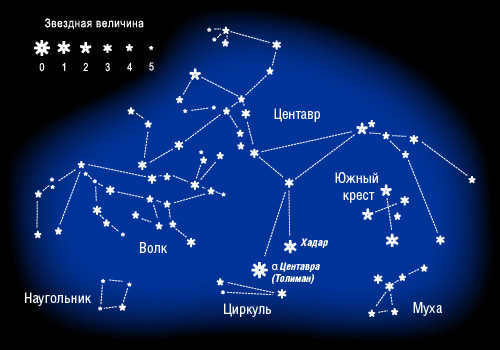
And what do we observe there? All together the Southern Cross, the Naugol, the Circlet, and the Triangle. Doesn’t that trigger a memory?
That’s not everything. Let’s acquaint ourselves with the composition of the constellation.
Hakrux is one of the four primary stars that form the Southern Cross. Similar to the other three instances, the name of the star reflects its membership and role in the constellation: ga-Crux or Gamma of the Southern Cross (while Acrux, Becrux, and Decrux are respectively its Alpha, Beta, and Delta).
It is the third most luminous star in the Southern Cross constellation. It is one of the most brilliant stars in the nighttime sky. Its official name is Hakruks, which is derived from its designation as Bayer γ (gamma) and the Latin name of the Crux constellation.
It is an optical double star that can be easily distinguished with powerful binoculars; however, its components are not gravitationally bound. The brighter component is situated 88 light-years away from the Sun. It is a cold red giant with a mass equivalent to three times that of the Sun and a luminosity of 1.5 thousand times that of the Sun. It is an ancient star that has already exhausted its hydrogen fuel in its core. It exhibits semi-regular variability. The star’s atmosphere is enriched with barium.
The second component is located at a distance of 400 light-years. It has a class A3 and an apparent luminosity of +6.4m, and it belongs to the white stars on the main sequence.
Chemistry is responsible for the green glow of stars, thanks to the presence of barium salts. However, this phenomenon is not visible to the naked eye from Earth. It is primarily due to the unique characteristics of human color vision, which differs from that of birds and snakes.
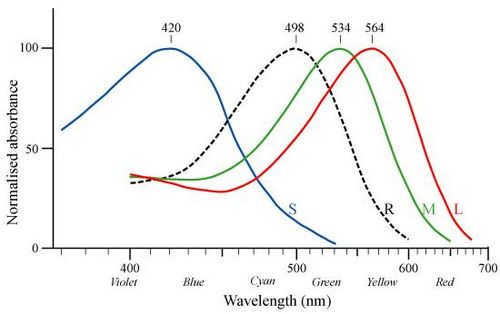
It is evident that the red and green light have a maximum sensitivity that is separated by only 30 nanometers. The blue light is much further away (120 nm), so when it comes to thermal radiation, we perceive either the edges (blue and red) or a combination (yellow or white). To isolate the “greens” from the spectrum, we require natural filters, diffusers, or prisms. During sunset or sunrise, an “atmospheric prism” blocks off the red and blue colors, resulting in the phenomenon known as the green ray of the Sun. This is primarily observed at sea where the horizon is flat, although not always. In desert dust storms, the green Sun is also observed, indicating that in space, the green glow can only be seen from dust nebulae. Essentially, if a star appears green, it means it is situated within a dust cloud.
Now, do you comprehend the origin of the green color in dragons, clones, serpents, elves, etc., and how it showcases their diversity? But that’s not all.
The second star in the constellation Becruxus. Mimosa (β Cru / β Crucis / Beta Crucis) is the second brightest star in the Southern Cross constellation (after Alpha Crucis) and the nineteenth brightest star in the night sky. The name Becrux is a combination of the Bayer β designation and the Latin name of the Crux constellation.
It is situated approximately 280 light-years away from the Sun. In 1957, German astronomer Wolf-Dieter Heinz made the discovery that Becrux is a binary star system with components that are too close together to be resolved with a telescope.
The primary component β Cru A is a massive variable star of the Beta Cepheid class. It has a mass 16 times that of the Sun and a surface temperature of 27,000 K.
Mimosa signifies variability!
Intersecting Circles and Naugols.
What is the origin of the letter “G”? Similar to how every woman possesses a desire and a G-spot, Freemasons have their own “G” spot.
In his “Masonic Encyclopedia,” Coyle raises an interesting question about the appearance of the letter “G” in the center of the crossed Circulus and Naugolnik. According to Coyle, this addition only occurred in 1850 on Masonic signs and pendants, and it was the decision of the jeweler-maker rather than a Masonic administrative body. However, further examination suggests that Coyle may have been mistaken as research indicates that the third element had actually appeared in the Masonic emblem a few years earlier. More information can be found here.
That’s the origin of the G-green Hakruks!
The Southern Cross constellation, as its name suggests, is visible to those living in the southern hemisphere. It cannot be seen from Russian territory. However, the name of this star cluster is familiar to many people from literature, including the famous explorer Jules Verne and the epic poet Dante. In addition to literary references, the Southern Cross constellation is also recognized from the Australian flag, where it represents the state of Victoria.
History of the Southern Cross Constellation
The celestial phenomenon known as the Southern Cross has a relatively young history. In ancient times, it did not yet take its current form, nor did it have a name or any mythological significance.
However, the Romans recognized the cluster of stars that make up the Southern Cross as an asterism, which they referred to as the Throne of the Emperor. Therefore, we can say that the earthly history of this group of stars predates its modern name. Ancient Arab astronomers were also familiar with the region where the Southern Cross is located, although they had a different name for it.
Australia, a country that enjoys the privilege of having unfettered access to the constellation, has its own unique legend. As per their belief, the Southern Cross represents two majestic cockatoos being pursued by a malevolent spirit (symbolized by the Coal Sack, which serves as a fitting hiding place for the stolen treasures).
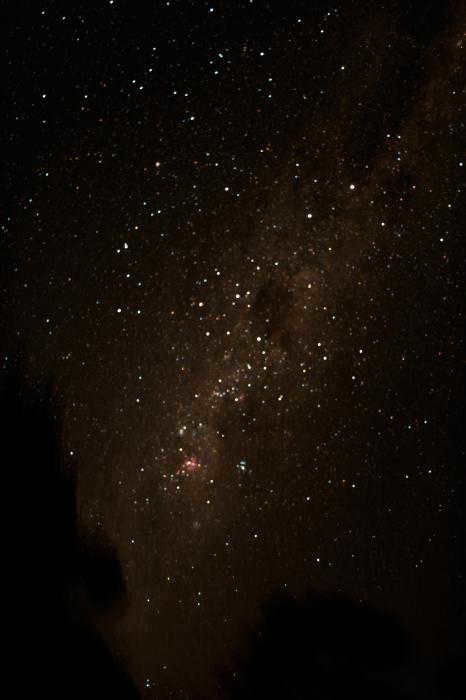
The Middle Ages in Europe gave rise to a captivating legend surrounding the expulsion of humanity’s first ancestors. It was believed that Adam and Eve wept as they witnessed the disappearance of the Southern Cross, a symbol of condemnation for their actions. Ever since that time, it is said that the Southern Cross has been hidden from the view of those living in the northern hemisphere.
Up until the 17th century, this group of stars was not recognized as a distinct constellation. Its stars were considered part of the Centauri constellation. According to different sources, the Southern Cross was “separated” either by Bayer (which occurred in 1603) or by the Frenchman Royer (which happened three quarters of a century later, in 1679).
Size of the Southern Cross
Many people mistakenly believe that the Southern Cross is a large and bright constellation due to its romanticized portrayal. However, without the aid of a telescope, this star cluster appears as a combination of four relatively bright stars that form a slightly slanted cross shape. The reason for this is that the other stars included in the constellation are quite faint and difficult to distinguish with the naked eye. In reality, the Southern Cross is a constellation consisting of more stars (approximately 30 in total), as clearly shown in the photo. However, compared to other constellations, this is considered a small number. For instance, the popular Big Dipper contains 125 stars, making it nearly twenty times larger than the so-called “big” Southern Cross.

Inaccuracy of the Name
If we strictly adhere to the name, then the constellation Southern Cross can be misleading as it includes a fifth “star” that is comparable in brightness to the four main stars and is visible without a telescope. It would be more accurate to describe it as a single celestial body without visual amplification, as it actually consists of dozens of stars of different colors. While the sight of it through a telescope is truly mesmerizing, it can be somewhat challenging for the average person to perceive the constellation as a cross.
The Significance of the Southern Cross in Orienteering
However, the reason behind the romanticization of this constellation is rather straightforward. In the southern hemisphere, it serves a similar purpose as Polaris does in the northern hemisphere. Just as our familiar “pointer” aids in determining the location of the north, the Cross guides the traveler towards the south.
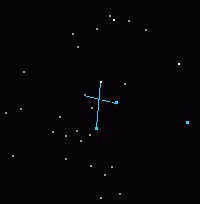

It is much more challenging to determine the southern direction using the Southern Cross constellation compared to finding the northern direction using Polaris. Within the Southern Cross, only two stars, Alpha and Gamma, also known as Acrux and Hakrux, point towards the south. These stars form the longer axis of the rhombus shape. In general, travelers can orient themselves in the correct direction using these stars. However, for more precise guidance, one must extend this diagonal four and a half times and locate a small star called Sigma Octana, which is positioned near the south pole. This requires a level of astronomical knowledge that only professional astronomers possess. Nevertheless, ancient sailors were able to navigate without the aid of modern, sophisticated instruments.
Aside from these challenges, the presence of another star cluster, which is also associated with the Southern Cross constellation, adds to the complexity. This nearby cluster is part of both the constellation of the Sail and the Southern Cross. Interestingly, the shape of this cluster resembles the Southern Cross, earning it the name False Southern Cross. While a trained eye can notice that the imposter’s cross section is angled in the wrong direction, those who were navigating these waters for the first time in the past were deceived and ended up heading in the wrong direction.
As I had promised, it is now the moment to share with you the intriguing details about the Brazilian flag and its enigmas.
Adorning the Brazilian flag are the shining stars and a glistening golden stripe. These stars are a representation of the celestial bodies that would have been visible to an observer standing outside the earthly realm above Rio Dejaneiro precisely at 8:30 a.m. (12 o’clock sidereal time) on the remarkable date of November 15, 1889 – the very day when Brazil was officially declared a republic. It is believed that the positioning of these stars underwent multiple adjustments, leading to the final design we see today.
There is a reference to the position of stars on the Brazilian flag – https://en.wikipedia.org/wiki/Flag_of_Brazil.
However, it appears that there are errors when it comes to the astronomical accuracy of these stars.
The arrangement of stars on the flag does not correspond to how they would actually appear in the sky. This arrangement can only be observed by someone outside of our planet, positioned much higher up in the sky above Rio de Janeiro, on the meridian. Only from that vantage point would the star epsilon of the Southern Cross (known as Yuchta) be seen on the left side of the constellation, opposite to how it is viewed from Earth (and how it is depicted on the flags of Australia, Western Samoa, Papua New Guinea, etc.).
Furthermore, the stars of the Scorpius constellation are depicted in a highly distorted arrangement in relation to each other. For example, on the flag, Antares and Shaula are shown as being almost next to each other, whereas in reality, Antares is located near the “head of Scorpio”, and Shaula represents the “sting” at the end of the “tail of Scorpio”.
Isn’t it strange – an onlooker from the outside? Being infinitely above.
But let’s put aside the discussion of this peculiarity for now.
On the flag, there is a representation of the southern hemisphere – the constellation “Southern Cross”. This constellation is of great significance as it helps with navigation by indicating the direction to the pole. However, it should be noted that the cross only points to the pole, and the precise position of the pole is determined through calculations.
However, simply observing the cross itself will suffice to determine the position of the pole on the horizon. You are free to go! The catch is, this phenomenon can only be witnessed from the southern hemisphere.
That’s where the captivating tambourine dances begin! Let me share with you the captivating history of this constellation.
“A novel constellation. Although the stars of the Southern Cross were recognized by ancient astronomers (in antiquity, it could be seen in the southern regions of Europe[source not specified 100 days], but it is currently invisible at these latitudes), it was not officially recognized as a separate constellation, and was included in the constellation Centaurus. However, as an asterism, the Southern Cross stood out in antiquity. Roman astronomers even referred to it as “The Emperor’s Throne” in honor of Augustus. Arab astronomers were familiar with it, and it is even mentioned in Dante’s “Purgatory” (early 14th century). The first European of the New Age to describe this group of stars was Amerigo Vespucci in 1501, who named it “Almond” (Italian La Mandorla, a term used in religious Italian art of that time). It was proposed as a distinct constellation on Plancius’s celestial globe in 1589, appeared on Emerie Mollineux’s globe of 1592, and on Jacob Bartsch’s map of 1624. However, Bayer’s Uranometria (1603) listed it as part of Centaurus, although it was distinguished as an asterism under the name “New Cross”. It was officially recognized as a separate constellation in scientific publications by Augustin Royer in 1679, to whom the credit for its introduction is attributed.
There are no classical myths associated with this constellation. However, the indigenous people of Australia interpret it as two cockatoos trying to enter a tree, or a possum seeking refuge in a tree from an evil spirit (represented by the dark nebula known as the Coal Sack). (Aha! I can’t help but wonder how the ancient Chinese overlooked it.)
According to medieval legend, our human ancestors, Adam and Eve, observed the stars forming the Southern Cross constellation from Earth’s Paradise, which was located in the Southern Hemisphere. Since then, the constellation has remained invisible to those inhabiting the Northern Hemisphere (according to the beliefs of that time, Africa and Asia did not cross the equator). [From T. Shekhovtsova’s notes on Dante’s “Divine Comedy”]
It is evident, is it not? The knowledge of this fact dates back to ancient times! And prior to that, the cross was present, but somehow it shifted to the southern hemisphere! However, these are all mere words without concrete evidence.
In order to comprehend my subsequent line of thinking, it is essential to recall the fundamentals of astronomy.
There exists a notion known as the celestial sphere, and the instrument employed by observers is the armillary sphere.
The armillary sphere, attributed to the ancient Greek geometer Eratosthenes (3rd century BC), is considered the oldest astronomical instrument. It was initially created as a tool for studying the celestial sphere, but later also served as a visual aid for teaching purposes.
In modern times, there is a widespread belief that the earth is flat, leading to debates among alternative thinkers. These discussions often revolve around the nature of stars – whether they are nails holding up the sky or sources of illumination. However, even with our advanced technology, we still struggle to accurately represent the vastness of the celestial sphere and its interactions with the southern hemisphere, which is symbolized by a turtle and a whale.
In the past, scientists had a different understanding of the world, depicted in a similar fashion to the concept of the matrix and the character Neo. It reminds us that sometimes we need to break free from our preconceived notions and explore beyond the limits of our current understanding.
The device was so innovative that it remained in use until the 20th century! It served as the inspiration for the flag of Brazil and the coat of arms of Portugal. Additionally, it was prominently displayed on top of the Kunstkamera in our country.
Despite its widespread use during its time, the device did not become a widely recognized symbol. A more contemporary version can be found in front of the League of Nations building or another organization affiliated with the “Commonwealth of Nations”. It is important not to confuse this with the United Nations. Remember this building and its name, as I will mention it again later!
Do you understand why someone in the northern hemisphere is unable to see the stars in the southern hemisphere? If the individual travels south, eventually they will be able to see the stars in the southern hemisphere. This particular region where the first previously invisible star becomes visible is known as the tropic. There is a tropic in both the southern and northern hemispheres. Beyond the boundaries of the southern tropic, one cannot see the stars in the northern tropic, and vice versa. However, if you are located in the tropics, you can see a portion of both hemispheres’ stars. This is all due to the fact that the Earth is round, a concept that Eratosthenes was aware of!
Now, let’s discuss the poles. The Earth’s axis of rotation points to the polar star in the northern hemisphere, and the entire visible hemisphere of stars revolves around it. However, there is no such star in the southern hemisphere. The Southern Cross points to this location, but it is just a reference point. In reality, there is a small star located in the Centaurus constellation, but we’ll discuss that later.
Here we have the celestial sphere, with the armillary sphere being the user’s apparatus for it.
Take a close look at the labels, particularly the one that indicates the ecliptic! The ecliptic is a large circle on the celestial sphere that represents the visible annual path of the Sun. The plane of the ecliptic intersects with the plane of the celestial equator at an angle of ε = 23°26″.
P, P” are the poles of the world, T, T” are the points of equinoxes, E, C are the points of solstice, P, P” are the poles of the ecliptic, PP” is the axis of the world, PP” is the ecliptic axis, ATQT” is the celestial equator, ETCT” is the ecliptic.
In other words, the golden belt on the flag of Brazil represents the ecliptic, which is the celestial circle that the Sun follows. It’s worth noting that the zodiacal constellations are found along the ecliptic belt! That’s how it was traditionally understood and depicted.
In summary, the Snake constellation has a rotational axis that is aligned with the polar star and “Hadar” (Beta Centauri). Hadar is the eleventh brightest star in the sky and is visually paired with a brightness of 0.8 and 4.0. The distance to this star system is 490 light years. If a straight line is drawn from Hadar to Alpha Centauri (which are 4.5 degrees apart), it will pass through the Southern Cross. These stars are commonly referred to as the Southern Pointers navigational asterism.
The name of this southern star, Hadar, has been known for a long time and originates from Arabic. It means “bottom” and there are also interesting interpretations like Aidar and others. You can find more information about Hadar here.
Any movement or expansion of the Earth’s continental plates, or any other event that does not involve a change in the rotation axis, will not alter the celestial sphere’s picture or orientations. Only a displacement or change in the position of the rotation axis will cause a shift in stellar orientations. However, it is evident that the orientation of the south pole, at least, has been known since ancient times. And despite the claim that the first Europeans arrived in the southern hemisphere in the 15th century, the starry sky of the southern hemisphere has been familiar for ages. Furthermore, it has not only been known but also studied for practical purposes, such as navigation!
Therefore, if there were any pole displacements or other catastrophes, they would have to involve an overturning of the Earth while maintaining the direction of the rotation axis. Is there any astronomical-historical evidence to support this? Yes, and it is quite unexpected.
For now, let’s explore the various theories of pole displacements, which have existed since ancient times! You can find more information on this topic here: https://en.wikipedia.org/wiki/Polar_shift.
The Crux constellation, also known as the Southern Cross, is the smallest constellation in the southern hemisphere of the sky. It is surrounded by other constellations. The Southern Cross is made up of four bright stars that form a recognizable pattern used for navigation. By drawing a line between the stars γ and α, one can approximate the location of the South Pole, which is 4.5 times the distance between the stars. This is particularly significant as there is no prominent polar star in the southern sky (although σ Octanta is a very faint star).
Within the constellation, there is the Coal Sack Nebula, a dark spot easily visible to the naked eye against the background. However, the true gem of the constellation is the Casket, which reveals its full beauty when observed in .
A new constellation has emerged. The stars of the Southern Cross, which were once unobservable for medieval European astronomers due to the precession of the Earth’s axis, were well-known to ancient astronomers. During Homer’s time, the Southern Cross could be seen throughout the Mediterranean, and during Ptolemy’s time, it was visible at the latitude of Alexandria. In ancient times, it was not recognized as a separate constellation but was instead part of the constellation Centaurus. However, the Southern Cross was distinguished as an asterism, and Roman astronomers referred to it as the “Throne of the Emperor” in honor of Augustus. It was also familiar to Arab astronomers, with references to it found in the star atlas of Kansar bin Abukasan from 1225.
The constellation referred to as “the hidden regions of the southern hemisphere” in the Book of Job (Job 9:9) could potentially be associated with the Southern Cross. It is believed to have been mentioned in Dante’s “Purgatory” (early 14th century).
One of the earliest Europeans to describe the group of stars was Amerigo Vespucci in 1501, who named it the “Almond” (or “La Mandorla” in religious Italian art at the time). The depiction of the star group as a cross can be traced back to at least 1515. The term “Southern Cross” was suggested as a distinct constellation on Plancius’ celestial globe in 1589, and it appeared on Emerie Mollineux’s globe of 1592 and Jacob Bartsch’s map of 1624. However, Bayer’s Uranometria (1603) listed it as part of Centaurus, although it was recognized as an asterism called the “New Cross”. It was officially recognized as a separate constellation by Augustin Royer in 1679, who is credited with its introduction.
There are no traditional tales surrounding the constellation. Indigenous Australians perceive it as a pair of cockatoos attempting to ascend a tree, or a possum seeking refuge in a tree while being pursued by a malevolent spirit known as the dark nebula Coal Sack.
As per medieval mythology, the ancestors of humanity, Adam and Eve, observed the stars aligning to form the Southern Cross constellation from the earthly paradise situated in the Southern Hemisphere (as per the beliefs of that era, Africa and Asia did not extend beyond the equator).
Finding the constellation in the night sky
The constellation can be seen in latitudes ranging from -90° to +26°. However, the Southern Cross is located quite far south of the celestial equator and is not visible in Russia. It is surrounded by neighboring constellations such as Centaurus and Fly. The Southern Cross is renowned for being one of the brightest and most prominent constellations in the southern hemisphere of the night sky. During the autumn season, it can be found in the southern part of the sky and is partially obscured by the horizon at midnight. To the right of the Southern Cross, at the same altitude, the bright Centauri stars can be seen.
In winter, the Southern Cross starts to ascend in the night sky and can be observed in the southeast. Its horizontal “crossbar” points towards the South Pole of the World, where an imaginary line drawn through it intersects with the meridian. Centauri is positioned at the bottom during this time.
In the summer months, the Southern Cross can be seen in the southwestern sky as it begins its descent towards the horizon. This is similar to the movement of the Big Dipper in the Northern Hemisphere, which also revolves around its pole. During this time, the constellation Centaurus is positioned above the Southern Cross.
The Southern Cross is a constellation that can only be observed by residents of the southern half of the world, excluding those in Russian territory. However, the name of this group of stars is familiar to many people from literature, including the renowned explorer Jules Verne and the epic poet Dante. Additionally, the Southern Cross is recognizable to many due to its presence on the Australian flag, where it represents the state of Victoria.
History of the Celestial Phenomenon on Earth
Let’s begin by acknowledging that the Southern Cross constellation is relatively young. In ancient times, it had not yet taken on its current shape, been given a name, or been mythologized.
However, the Romans identified the Southern Cross as an asterism, or a cluster of stars, which they called the Throne of the Emperor. Therefore, we can say that the earthly history of this group of stars predates its modern name. Ancient Arab astronomers also recognized the area where the Southern Cross constellation is now situated, although they had a different name for it.
The Australians, who have the privilege of having “unrestricted access” to the constellation, hold their own unique belief. According to their interpretation, the cross represents two majestic cockatoos being pursued by a malevolent spirit (symbolized by the Coal Sack, which is fittingly positioned as the hiding place for stolen treasures).
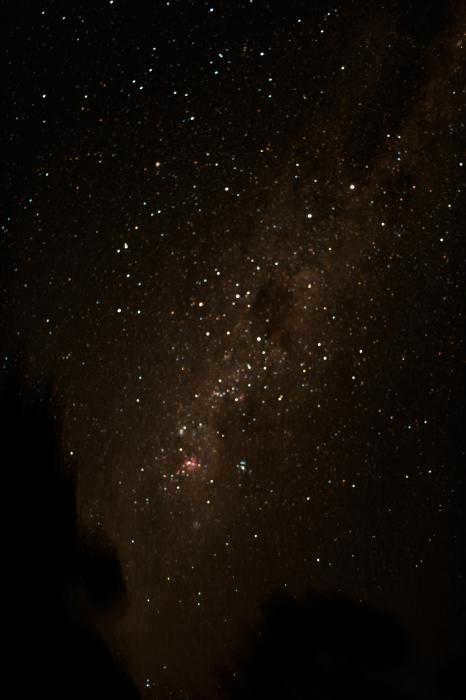
The European Middle Ages gave rise to a captivating myth surrounding the downfall of the first humans. It was believed that Adam and Eve witnessed with sorrow the disappearance of the Southern Cross, which symbolized the transgression of our ancestors. Since then, it is said to be hidden from the view of those living in the northern hemisphere.
Until the 17th century, this star cluster was not recognized as a separate constellation, and its stars were considered part of the Centauri constellation. According to different sources, the Southern Cross was “discovered” either by Bayer (in 1603) or by the Frenchman Royer (around 1679).
The well-known title emerged as a result of the Magellanic expedition across the globe, but it was officially established only in the 18th century. The reason for labeling these four stars as the “Southern” constellation was to differentiate them from what was commonly referred to as the Cross during that time period.
Size of the constellation
Due to the excessive romanticization of the Southern Cross, individuals who are distant from the field of astronomy have a misconception that it is a large and brilliant constellation. However, without the aid of a telescope, this star cluster appears as a combination of four bright stars, forming a slightly slanted cross. The reason for this is that the other stars within the constellation are quite faint, making them difficult to distinguish with the naked eye. In reality, the Southern Cross is a constellation (as clearly shown in the photo) consisting of a larger number of stars (approximately 30). However, in terms of constellations, this is a relatively small amount. For instance, the popular Big Dipper comprises 125 luminous stars, making it nearly twenty times larger than the so-called “big” Southern Cross.

Inconsistency in Name
If we strictly adhere to the name, the constellation Southern Cross is referred to as a cross due to the presence of a fifth “star” which is equally bright as the four main stars, making it visible even without the use of a telescope. It would be more accurate to describe it as a single source of light without visual enhancement, as it is actually composed of multiple stars of varying colors. While the view through a telescope is truly mesmerizing, for an ordinary person it can make the perception of the constellation as a cross somewhat more complicated.
The Significance of the Southern Cross for Navigation
However, the glorification of this star formation is easily understood. In the southern hemisphere, it serves a similar purpose as Polaris in the northern hemisphere. Just as our familiar “pointer” helps us locate the north, the Cross guides travelers in determining the south.

The primary clarification is that determining the southern direction using this constellation is much more challenging than determining the northern direction using Polaris. Only two stars in the Southern Cross point south: Alpha and Gamma, also known as Acrux and Hakrux. They form the longer axis of the rhombus. In essence, the traveler can orient themselves in this direction. However, for a more precise indication, one should extend this diagonal four and a half times, where a small star with the simple name Sigma Octana can be found, which is essentially above the south pole. Therefore, to perform all these calculations, one must possess the skills of a nearly professional astronomer. Nevertheless, ancient sailors managed to navigate without the use of modern, complex, but accurate devices.
Another challenge
In addition to the aforementioned challenges, there is another hurdle when it comes to orientation. The presence of a similar star cluster, which is aided by the Southern Cross constellation, further complicates matters. This cluster is situated nearby and is associated with both the constellation of the Southern Cross and the constellation of the Sails. Interestingly, the shape of this asterism bears a striking resemblance to the southern “pointer” star, which is why it is referred to as the False Southern Cross. A discerning eye can notice that the deceptive cross is angled in the incorrect direction. However, in the olden days, those who were navigating these waters for the first time would often be misled and end up heading in the wrong direction.
Legend and history
In ancient times, the region that is now the Southern Cross constellation was part of Centaurus. There are historical accounts of a star pattern called the “Throne of the Emperor,” which was named in honor of the Roman Emperor Octavian Augustus. The constellation was also known as “Caesar’s Throne” by the Romans, who could observe it from Alexandria.
The first documented mention of the Southern Cross constellation was made by Amerigo Vespucci in 1507. About 170 years later, in 1679, Augustin Royer depicted this section of the sky separately from the constellation Centaurus on star maps and named it the Southern Cross.
Many sailors in the Southern Hemisphere frequently relied on this constellation due to its proximity to the South Pole. The South Pole of the world is easily accessible from this location. Furthermore, if one were to trace a straight line connecting the two prominent stars at the bottom of the cross, it would accurately indicate the direction towards the pole.
Characteristics
| Latin name | Crux |
| Abbreviation | Cru |
| Area | 68 square degrees (ranked 88th) |
| Direct ascent | From 11:50 am to 12:50 pm |
| Declination | From -64° to -55° |
| Brightest stars | The star’s atmosphere contains barium. The second component is located 400 light-years away, has class A3, an apparent magnitude of +6.4, and is a main-sequence white star. |
Did you know that barium salts can make flames appear green? It’s like having a star with a green glow.
However, we humans cannot see this green glow from Earth. This is mainly due to the way our color vision works (birds or snakes, for example, perceive colors differently).
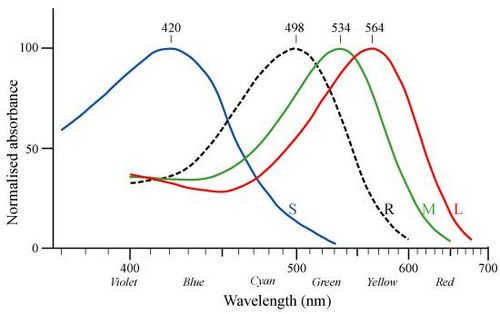
One can observe that there is a slight difference of only 30 nanometers between the maximum sensitivity for red and green light. However, the blue light is much further away at 120 nm, which means that when it comes to thermal radiation, we only perceive the edges (blue and red) or a combination (yellow or white). In order to isolate the “greens” from the spectrum, natural filters, diffusers, or prisms are needed. During sunset or sunrise, the “atmospheric prism” blocks out the red and blue colors, resulting in the green ray of the Sun. This phenomenon is mainly observed at sea where the horizon is flat, although it can occur in other locations as well, such as during dust storms in deserts. In space, the green glow can only be seen from dust nebulae. In general, if a star appears green, it is likely situated within a dust cloud.
Now you can observe the origin of the green hue in mystical creatures like dragons, clones, serpents, elves, and many more. This green color serves as an emblem of their boundless diversity. However, there is more to discover.
The second luminary in the constellation Becruxus is Mimosa (β Cru / β Crucis / Beta Crucis). It holds the position of being the second most radiant star within the Southern Cross constellation, trailing only behind Alpha Crucis. Furthermore, it ranks as the nineteenth brightest star in the entire night sky. Becrux derives its name from the Bayer β classification and the Latin designation of the constellation Crux.
Remarkably, it is situated at an immense distance of 280 light-years from our Sun. In 1957, the distinguished German astronomer, Wolf-Dieter Heinz, made an astounding revelation – Becrux is actually a double star system, with its components being so close together that they cannot be individually distinguished even with the assistance of a telescope.
The primary component, β Cru A, is an enormous variable star belonging to the Beta Cepheid category. It possesses a mass 16 times greater than that of the Sun and boasts a surface temperature of 27,000 K.
The origins of the letter “G” are a mystery, much like the enigmatic G-spot that every woman possesses. Similarly, Masons have their own secret spot, known as the G-spot.
Coyle states in his “Masonic Encyclopedia” that the letter ‘G’ was not added to the center of the crossed Circlet and Naugol until 1850. He clarifies that this decision was made by the jeweler-maker and not by any Masonic administrative body. Coyle also argues that the ‘G’ is completely inappropriate between the Circlet and the Naugolnik, as the latter represents the Great Luminaries while the ‘G’ does not. However, further research has shown that Coyle’s statement was not entirely accurate, as the third element had actually appeared in the Masonic emblem a few years earlier. Source
It is uncertain where the origin of the “G” comes from or if the information is being concealed. If it first emerged in 1850, it suggests that Freemasonry itself is not older than 1850, and the serpent-elf did not exist prior to that. Additionally, the Jews Holstein, who supposedly conquered the entire planet alongside the serpent, only appeared in 1853. Gradually, the puzzle is being solved and certain enigmas are being clarified.
This is the genesis of the G-green Gakruks!


As I promised, it’s time to share the fascinating story behind the Brazilian flag and its enigmatic symbolism.
The Brazilian flag proudly displays a constellation of stars and a striking golden stripe. These stars are said to represent the celestial bodies that would have been visible to an observer outside the celestial sphere over Rio Dejaneiro precisely at 8:30 am (12 o’clock star time) on the historic day of November 15, 1889 – the day Brazil declared itself a republic. It is believed that the positions of the stars were meticulously adjusted to capture this significant moment in time, resulting in the captivating design we see today.
There is an indication of the placement of stars – https://ru.wikipedia.org/wiki/Flag_of_Brazil.
However, it turns out that there are some astronomical errors.
The stars on the Brazilian flag do not actually appear in the sky as they are depicted: this arrangement of stars can only be seen by an observer located outside the Earth’s atmosphere, infinitely higher up on the meridian of Rio de Janeiro – only then would the star epsilon of the Southern Cross (also known as the star Yuchta) be seen on the left side of the constellation, opposite to how it is seen by people from Earth (and how it is shown on the flags of Australia, Western Samoa, Papua New Guinea, etc.).
The stars of the Scorpius constellation are shown in a highly distorted arrangement compared to their actual positions. For example, on the flag, Antares and Shaula are depicted as being almost next to each other, while in reality Antares is located near the “head of Scorpio” and Shaula is the “sting” at the tip of the “tail of Scorpio”.
However, let’s temporarily put aside the discussion of this peculiar phenomenon.
On the flag, there is an emblem of the southern hemisphere – the constellation known as the “Southern Cross.” This constellation holds significant importance as it serves as a navigational tool, helping individuals determine the direction towards the pole. However, it is important to note that the cross merely points towards the pole, and the exact position of the pole is determined through calculations.
However, it is generally sufficient to observe the cross itself, and its base will indicate the position of the pole on the horizon. You are good to go! Nevertheless, there is a catch – the Southern Cross can only be seen from the southern hemisphere.
That’s where the fascinating tambourine dances begin! Here is what they say about the history of this constellation.
“A new constellation. Although the stars of the Southern Cross were known to ancient astronomers (during antiquity, it could be observed in the south of Europe[source not specified 100 days], currently it cannot be seen at these latitudes), they did not classify it as a separate constellation, including it in the Centaurus constellation. However, it stood out as an asterism in antiquity. Roman astronomers referred to it as “The Emperor’s Throne” in honor of Augustus. It was also known to Arab astronomers and mentioned in Dante’s “Purgatory” (early 14th century). The first European of the New Age to describe this group of stars was Amerigo Vespucci in 1501, who named it “Almond” (Italian La Mandorla, a term used in religious Italian art at the time). It was proposed as a separate constellation on Plancius’s celestial globe in 1589, appeared on Emerie Mollineux’s globe of 1592, and on Jacob Bartsch’s map of 1624. However, Bayer’s Uranometria (1603) listed it as part of Centaurus, although it was distinguished as an asterism under the name “New Cross”. It was introduced as a separate constellation in scientific publications by Augustin Royer in 1679, who is credited with its introduction.
There are no classical myths associated with this constellation. However, the indigenous people of Australia see it as two cockatoos trying to perch on a tree, or a possum seeking refuge in a tree from the pursuit of an evil spirit (the dark nebula Coal Sack). (Aha! Well, it’s surprising how the ancient Chinese were overlooked.)
According to medieval legend, the ancestors of humanity, Adam and Eve, saw the stars forming the Southern Cross from Earth’s Paradise, which was located in the Southern Hemisphere. Since then, the constellation has become invisible to people inhabiting the Northern Hemisphere (according to the beliefs of that time, Africa and Asia did not cross the equator). [From T. Shekhovtsova’s notes on Dante’s “Divine Comedy”]
Isn’t it obvious, you see? It’s been a well-known fact for ages! And even before that, the cross was present, but somehow it shifted to the southern hemisphere! But all of this is just poetic expression, without any evidence to support it.
In order to comprehend my subsequent arguments, it is imperative to recall the fundamentals of astronomy.
There exists a concept known as the celestial sphere, and the tool used by observers is the armillary sphere.
The armillary sphere, which is considered the oldest astronomical instrument, was reportedly invented by the ancient Greek geometer Eratosthenes in the 3rd century BC. Over time, it was also utilized as a visual aid to teach about the celestial sphere.
Currently, there seems to be a widespread belief that the Earth is flat. However, debates among different groups on the internet mainly revolve around the nature of stars – whether they are nails holding up the sky or sources of light. Nonetheless, even with modern technology, it is still challenging to accurately represent the stars and the appearance of the southern hemisphere. It seems that the presence of a turtle and a whale further complicates the matter.
In the past, scientists used to have a more sophisticated understanding of the world. It was depicted as if in a matrix, much like in the movie “The Matrix” with the character Neo. To truly understand, one must transcend the limitations of the matrix!
However, Eratosthenes, the ancient scholar, did not dine using his hands. He possessed the knowledge that the Earth is a spherical shape and that the stars surrounding it form the celestial sphere. To aid in his understanding, he created a simple apparatus known as an armillary sphere!
Presented here is the Vatican’s version of this device.
The armillary sphere was so effective that it remained in use until the 20th century! Furthermore, it served as the inspiration for the flags of Brazil and Portugal, as well as the coat of arms of Portugal. In Russia, it was even placed atop the spire of the Kunstkamera.
Despite its widespread use during its time, the armillary sphere did not become a widely recognized symbol. Its most contemporary form can be seen outside the building housing the League of Nations or another organization known as the “Commonwealth of Nations”. It is important to distinguish this building from the United Nations. Remember this structure and its name, as it will be revisited later!
Do you understand why stars from the southern hemisphere cannot be seen by an observer from the northern hemisphere? When the observer travels south, eventually the stars from the southern hemisphere become visible. This area where the first previously invisible star appears is called the tropic. There are both southern and northern tropics. Outside the boundaries of the southern tropic, the stars from the northern tropic cannot be seen, and vice versa. However, if you are in the tropics, you can see a part of both hemispheres’ stars due to the round shape of the Earth, as Eratosthenes discovered!
Let’s talk about the poles now. The Earth’s axis of rotation points to the northern hemisphere’s polar star, around which the entire visible hemisphere of stars rotates. However, there is no such star in the southern hemisphere. The southern cross indicates this location, but it is only an indication. In reality, there is a small star there, which is located in the Centaurus constellation. We will discuss it later.
Here we have the celestial sphere, which is operated by the armillary sphere.
Take a close look at the labels, especially the ecliptic! The ecliptic is a large circle on the celestial sphere where the Sun’s visible annual motion takes place. The plane of the ecliptic intersects with the plane of the celestial equator at an angle of ε = 23°26″.
P,P” are the poles of the world, T,T” are the equinox points, and E,C are the solstice points. P,P” are the poles of the ecliptic, PP” is the axis of the world, and PP” is the ecliptic axis. ATQT” represents the celestial equator, and ETCT” represents the ecliptic.
So, the golden belt on the flag of Brazil represents the ecliptic, which is the celestial circle of the Sun’s path. It’s important to note that the zodiacal constellations are located along the ecliptic belt! That’s how it was traditionally believed and done.
Now, to add more intrigue to the story, allow me to unveil the flag that stands out from the rest with its depiction of the Polar Star. Behold, the flag of Alaska!

When embarking on a journey, it’s essential to come prepared for any situation. While having a CLMN and warm socks in your backpack is undoubtedly important, there is something even more crucial – survival. And how can one survive without the ability to navigate the terrain?
Overcoming topographical challenges and acquiring orienteering skills is arguably one of the primary abilities of a true survivalist.
So, if you find yourself lost in unfamiliar surroundings, fear not. A lesson in orienteering using astronomical objects can guide you towards your desired destination.
Orienteering with the aid of the sun
Let’s start, maybe, with our indispensable companion – the Sun. It is important to recall one firm principle: at midday, the Sun is typically positioned in the north in the southern hemisphere, and in the south in the northern hemisphere.
To ascertain which hemisphere you are situated in, observe your own shadow. If you happen to be in the northern hemisphere, your shadow will rotate in a clockwise direction, whereas in the southern hemisphere it will rotate in the opposite direction.

Locate a stick that measures one meter in length on the ground. Once you are outside on a flat surface, insert the stick into the ground. It will then cast a shadow.
Make a mark at the outermost point of the shadow (X) and wait. After 15 minutes, mark the extreme point of the shadow once again (Y). Now, connect these two points with a line: the initial point represents the west direction. If you need to move in the north-south direction, the line will be perpendicular to the segment XY (AB in the image).
At times, a mechanical wristwatch becomes more than just an accessory; it becomes an essential tool for a survivalist. With the assistance of a watch, we can accurately discern the cardinal directions and, as a result, avoid getting lost.
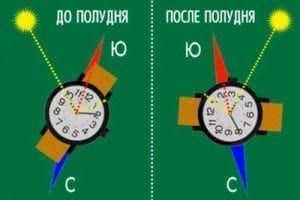
The watch needs to display the local time, but when we calculate the location, we don’t take into account the minute and second hands. The process is quite simple and effective.
To determine the direction, we position the hour hand directly towards the Sun, creating an angle between the hand and the number 1 (13 hours). We then divide this angle in half with an imaginary line, resulting in: facing front – south, facing back – north.
It’s important to note that until 1 o’clock, we only divide the angle on the left side, and after that – only on the right side.
Navigation with the Moon
On occasion, the Moon serves as the sole reference point for nighttime navigation. By gauging the current phase of this celestial body, one can effortlessly ascertain the cardinal directions.
For instance, when the Moon is waxing (with the convex part of the semicircle on the right), it can always be found in the western part of the sky. Conversely, when the Moon is waning (with the convex part of the semicircle on the left), it can be spotted in the eastern part of the sky.
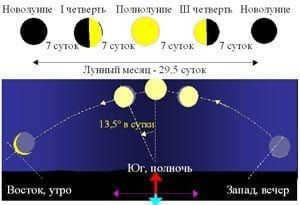
When attempting to navigate using the moon, it is important to keep in mind the following:
- The first quarter of the moon is positioned in the southern direction until 19:00 local time.
- The full moon gradually moves towards the southeast until 22:00.
- By 4:00 a.m., the moon can be found in the southwestern direction.
- At 7:00 a.m., the last quarter of the moon can be observed in the southern direction.
Using the stars for orientation
In the Northern Hemisphere, the Polaris star stands out
The Great Bear and the Little Bear constellations.
We must not overlook the significant landmark that is the well-known Polaris. It distinguishes itself from other stars with its unwavering presence. It never fails travelers in different hemispheres and always remains in the same position.
Throughout the night, Polaris accurately points north with a maximum margin of error of 1.5 degrees. This slight deviation is negligible, making this landmark a valuable asset for travelers.
Some believe that Polaris is the brightest star in the sky, but this is far from accurate. There are numerous stars that are much brighter than Polaris.
Now, we can locate Polaris by drawing an imaginary line from the two stars in the “bucket wall” of the Big Dipper to the handle of the Little Bear’s bucket, which is located at the end of the constellation. This star is our target: Polaris.
Another way to find Polaris is by using the constellation Cassiopeia. This constellation is easily visible against the backdrop of the Milky Way. To identify it, look for the shape that resembles the letter “M” or the letter “W” in English.
By drawing a straight line from the center star on the left side of Cassiopeia, we will be able to locate Polaris…
Southern Hemisphere
Southern Cross
If someone fortunate enough to find themselves in the southern hemisphere, they will have the opportunity to use the Southern Cross constellation as a reliable point of orientation. As its name suggests, this constellation points directly towards the south pole.
The Southern Cross constellation consists of four stars, which aptly justify its name, as their positioning truly resembles a cross.
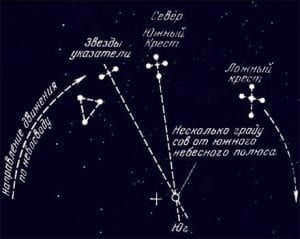
However, caution should be exercised when using the Southern Cross as a guide, as there is a risk of mistaking it for the False Cross. The False Cross can be distinguished by its faint and unremarkable stars, as well as the greater distance between them. Additionally, to the left of the genuine Southern Cross, two stars can be observed, providing an additional point of reference.
To determine the correct direction towards the south, it is necessary to draw an imaginary line through the vertical axis of the Southern Cross. This can be done by mentally connecting the guiding stars and extending a perpendicular line from the midpoint of this connection. The point where the two lines intersect, representing the stars and the Southern Cross, will indicate the location of the South Pole.





